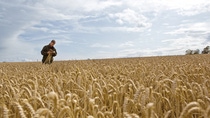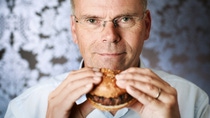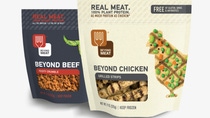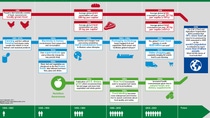How will we feed ourselves in the future?

The United Nations (U.N.) predict that by 2050 we will need to increase food production by 70% to feed the world. There is no single solution to this challenge, but it is prompting some innovative ideas that could profoundly change the way we eat.
In 1931, Winston Churchill predicted in an article for The Strand Magazine that the time would come when scientists would use microbes to grow meat in laboratories, much as bakers use yeast to make bread. Eighty-two years later Churchill’s prediction became a reality: In 2013, Mark Post, PhD and Professor of Physiology at the University of Maastricht, made scientific and culinary history by presenting and then eating a burger that he had grown in his laboratory in Maastricht. Even today, for many, the idea of lab-grown meat is outlandish. But as a perfect storm of events gathers to threaten global food security, there are a growing number of reasons to believe it is an idea whose time has come.
“I entered into this to address the problems I find most pressing, which are threats to food security and the environmental cost of beef production.”
Professor Mark Post, PhD, University of Maastricht

Last year the global population reached 7.2 billion and is set to reach over 9 billion by 2050. While one in nine still does not have enough food for a healthy life, there has been a significant rise in the middle classes, who are predicted to reach 4.9 billion by 2030. With this newfound wealth comes an appetite for meat, eggs and dairy products – the kind of high-value, high-protein diet so long associated with the West. Meanwhile, the way we grow livestock has a huge impact on the environment as one of the greatest sources of greenhouse gases.
With all these challenges, how can we improve food production, supply and nutrition while preparing for a world population of more than 9 billion? We have to start thinking urgently about how to meet this additional demand in a sustainable way. A good starting point is meat. Global meat consumption is on the rise. By 2050, consumption of meat worldwide is expected to rise by 76%. However, methane from cows is 25 times more effective as a global warming agent than CO2.

Many see an alternative in the world of insects. They cause fewer greenhouse gas emissions, they require significantly less land and water than cattle rearing, and insects such as crickets only need 2 kilograms of feed for every 1 kilogram of bodyweight gain. In 2013, the U.N. Food and Agriculture Organization (FAO) carried out a major study into edible insects and their prospects as an alternative food. Insects already form part of the traditional diet of 2 billion people and 1,900 species are used as food. They score high by practically every criterion you wish to judge them on – they are a highly nutritious food source of good types of fat.
Yet, despite their merits, insects have failed to catch on in the West where eating insects is not culturally acceptable and transitioning to a meat-free diet is a challenge. Which is one reason why Post, in his Maastricht laboratory, has committed himself to finding a way to meet the global demand for meat without impacting the environment or even harming animals. Hence the lab burger.
“We want to be the next great global meat company. We want to speak to meat reducers who are looking for different solutions.”
Brent Taylor, co-founder of Beyond Meat

The process he has developed requires taking a small biopsy from a living cow. Around a hundred skeletal muscle stem cells are harvested and then cultivated to the point where it is theoretically possible to produce a hundred metric tons of meat from a single sample. Post and his team believe it will take up to seven years for the product to get through Europe’s strict food regulatory process. Post himself also admits that it will be a while before lab-grown meat is generally acceptable. But a recent survey of German customers by the food company Nestlé may give Post hope. It asked people about their attitudes to alternative sources of protein and revealed that, in 15 years, lab-grown meat could well be as acceptable to consumers in Germany as sushi is today.
In the meantime, other ideas are emerging that may be more easily achievable. Brent Taylor is the co-founder of Beyond Meat, a company that has broken the mould of traditional plant-based meat substitutes by producing an alternative using pea and soy protein that is so close to meat and chicken that it is targeted at meat eaters as well as vegetarians. According to Taylor, the company’s ambitious aim is to cut global meat consumption by 25% by 2020: “We want to be the next great global meat company. We want to speak to meat reducers who are looking for different solutions. Past efforts were for a vegan or vegetarian market, so these products did not fulfill the experiences of somebody who enjoys the experience of meat. For us, it is always, how do we create not only the structure of meat but the fantastic sensory experience of meat,“ explains Taylor.
“Consumers understand that their health is their new wealth. They seek holistic solutions which establish, develop and support long, healthy and active lives.”
François Scheffler, Vice President Human Nutrition at BASF

Taste, texture and smell – all these sensory elements play a critical role in our experience of eating and, along with cultural norms, define our attitudes toward food. The problem is that, in spite of increasing awareness, these forces often draw us to foods that are not sustainable or healthy. So how can we make a healthy, sustainable diet more appealing? This is a conundrum that the multinational agricultural, food and feed company Cargill recognizes. “The consumer wants less of the bad – things like eliminating trans fat, lowering saturated fat – and the addition of the good – things like Omega-3,” explains Kyle Marinkovich, Assistant Vice President Marketing at Cargill.
Omega-3 is a good example. Awareness of the benefits of eating fatty fish – a rich source of Omega-3 – is on the rise. Omega-3 fatty acids can help in the prevention of diseases, such as metabolic diseases, cognitive decline and cardiovascular disease. Yet surveys show most people around the world still fail to eat enough of it. One of the reasons often cited is that the taste and smell is off-putting. Solutions to this problem are tasteless fish oils that can be added to foods without changing the flavor – thus providing the healthy ingredient without altering customer expectation or taste – and highly concentrated Omega-3 capsules.

Working with new impulses, scientists are discovering new ways to improve our health by finding even better ways to increase the nutritional content of our diets. BASF, for example, provides pure and highly concentrated Omega-3 fatty acids for use in consumer health, clinical nutrition and pharmaceutical products. “A hard line between food for energy and pharmaceuticals to correct disease is no longer relevant. Consumers understand that their health is their new wealth. They seek holistic solutions which establish, develop and support long, healthy and active lives,” says François Scheffler, Vice President Human Nutrition at BASF, who confirms that nutritious foods and special nutrition, including dietary supplements, are a growing market.
Our concerns about population growth, health and the environment are leading us to look for new ways of feeding ourselves. They have spawned a whole new movement of so-called “food hackers”, who have adopted the Silicon Valley approach of using technology to make life better and have applied it to food. At a recent Food Hackathon in San Francisco, California, food innovators, entrepreneurs, scientists and technologists came together to explore how emerging technologies and sciences can reshape the “global food web,” and provide affordable nutrition for all. Much of this is still visionary and some of the ideas might take some time getting used to. Because food is more than nutrition. It binds us to family and culture and is a source of great pleasure for many. We are protective about our relationship with food and are reluctant to change our eating patterns. Which is why there is no single alternative solution emerging as to how we will sustainably feed ourselves in the future. Whether it is lab-grown meat, insects or vegetable protein, the transition will be slow, but the possibilities are diverse and ideas are out there. Who knows what we will be eating in 30 years, but one thing is certain: The journey has clearly begun.
